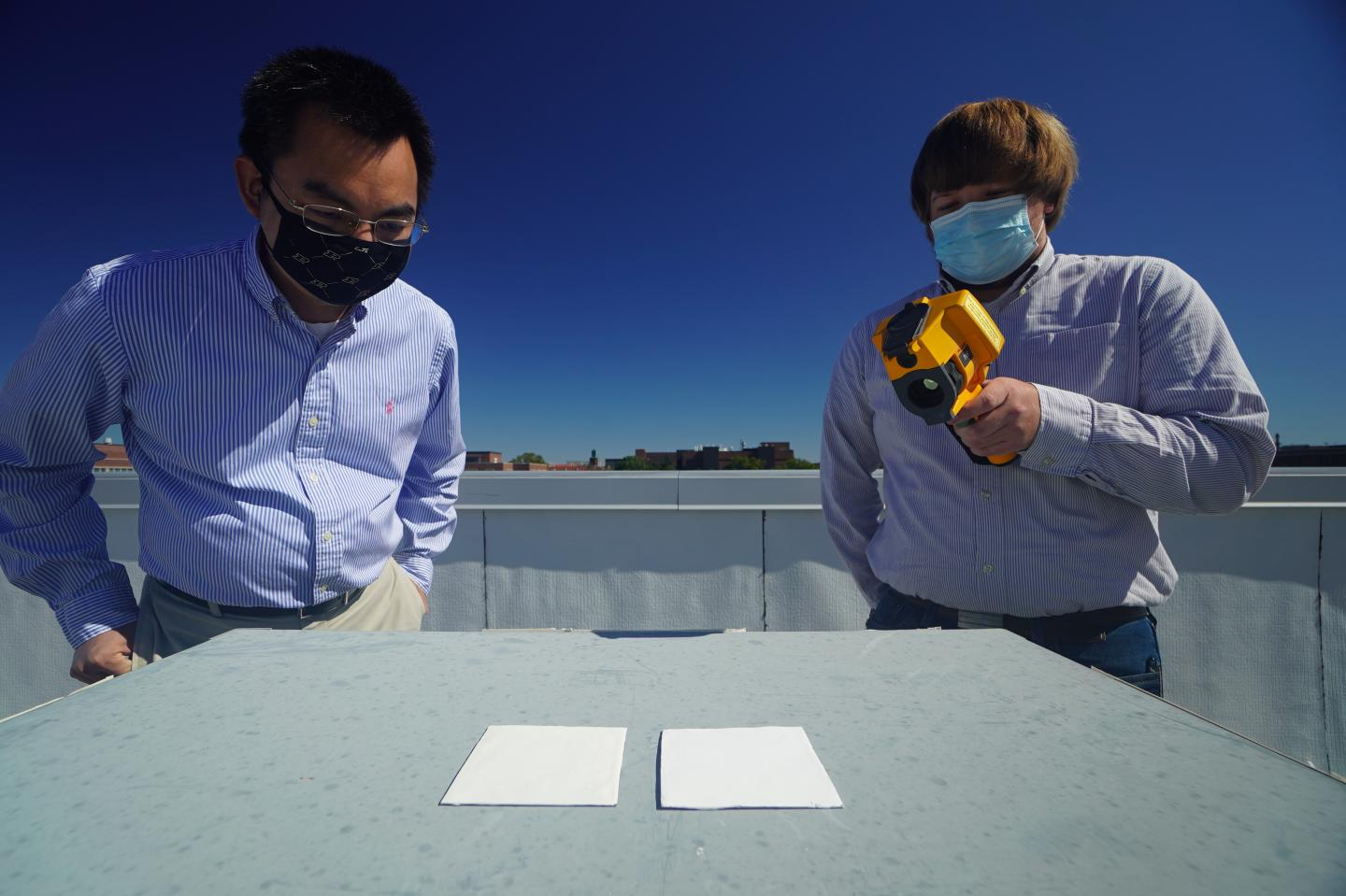Oct 22 2020
A white paint capable of cooling below the temperature of its ambient settings even under direct sunlight has been developed by a team of researchers.
 This photo shows Professor Xiulin Ruan (left) and Ph.D. student Joseph People (right) studying the Purdue radiative cooling paint and the commercial paint samples placed side by side. Image Credit: Jared Pike of the School of Mechanical Engineering at Purdue University.
This photo shows Professor Xiulin Ruan (left) and Ph.D. student Joseph People (right) studying the Purdue radiative cooling paint and the commercial paint samples placed side by side. Image Credit: Jared Pike of the School of Mechanical Engineering at Purdue University.
The study, published in the October 21st issue of the Cell Reports Physical Science journal, describes a radiative cooling technology that could be added to commercial paints that could be economical to produce and passively reflects 95.5% of the sunlight that touches its surface back into the atmosphere.
On the other hand, existing commercial “heat rejecting paints” can only reflect 80%–90% of solar irradiation and cannot cool to below-ambient temperatures.
During the summertime and in areas with warm climates, a majority of the buildings depend on traditional air conditioning systems to convey heat from the inner side to the outdoors. These systems need energy, produce excess heat that turns cities into “heat islands,” and add to the climate crisis.
Although researchers have been keen on creating radiative cooling paints since the 1970s, paints created earlier were not able to reflect adequate sunlight to serve as feasible, commercializable substitutes to conventional air conditioners.
It is a persistent task to develop a below-ambient radiative cooling solution that offers a convenient single-layer particle-matrix paint form and high reliability. This is critical to the wide application of radiative cooling and to alleviate the global warming effect.
Xiulin Ruan, Study Author and Professor, School of Mechanical Engineering, Purdue University
In their attempt to create a commercially relevant radiative cooling paint, Ruan and team used calcium carbonate fillers, an abundant compound, rather than the regular titanium dioxide particles, since the fillers possess large band gaps (energy variances between the valence electron band and the bottom of the conduction electron band) that help reduce the amount of UV light absorbed by the paint.
The scientists also utilized a high particle concentration of 60%, which increases the scattering of sunlight, as well as an extensive particle size distribution rather than a single particle size for effective broadband scattering.
The researchers carried out cooling tests in West Lafayette, Indiana for two days to show how well these adjustments improved the radiative cooling abilities of the paint. The temperature of the paint sample stayed 10 °C below the ambient temperature at night and a minimum of 1.7 °C below the temperature of the ambient surroundings when the Sun was at its peak. (The cooling power was demonstrated to surpass 37 W/m2 under direct sun.)
Then, Ruan and his team conducted a second test where part of a pattern was painted using the novel paint while another part was painted using an already existing white paint of the same thickness. An infrared camera showed that the calcium carbonate-based acrylic paint could maintain a lower temperature under direct sunlight compared to its commercial equivalent.
Ruan anticipates that the technology may be advantageous to several industries, including warehouses, commercial and residential buildings, military infrastructures, data centers, food storage, outdoor electrical equipment, automobile, and utility vehicles.
The paint can be coated straight onto buildings to decrease cooling costs. Since the paint does not have any metallic components, telecommunication companies could use it to stop outdoor equipment from overheating, a crucial step toward facilitating a 5G network.
This paint may even be used to combat climate change since it rejects sunlight and radiates heat into space.
Xiulin Ruan, Study Author and Professor, School of Mechanical Engineering, Purdue University
Going forward, the team plans to conduct long-term reliability studies to test the resistance of the paint to water, UV light exposure, surface adhesion, dust, and detergent to enable its use as a commercial product.
Our paint is compatible with the manufacturing process of commercial paint, and the cost may be comparable or even lower. The key is to ensure the reliability of the paint so that it is viable in long-term outdoor applications.
Xiulin Ruan, Study Author and Professor, School of Mechanical Engineering, Purdue University
This study was financially supported by the Cooling Technologies Research Center at Purdue University and the Air Force Office of Scientific Research through the Defense University Research Instrumentation Program.
Journal Reference:
Li, X., et al. (2020) Full Daytime Sub-ambient Radiative Cooling in Commercial-like Paints with High Figure of Merit. Cell Reports Physical Science. doi.org/10.1016/j.xcrp.2020.100221.
Source: http://www.cellpress.com